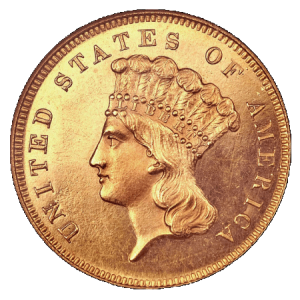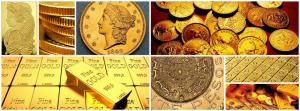Invest in Gold in 2016
More and more advertisements touting gold as an investment seem to pop up these days on TV, radio and especially the internet. Financial advisors have recommended investors for years to diversify their portfolios by holding about 10 % of their financial assets in gold as a way to hedge against economic uncertainty as well as inflation. But in which way should you invest in gold? Stock in a gold mining firm, financial instruments involving gold (often referred to as paper gold), gold bullion coins, rounds or bars or even historic (pre 1933) gold coins, there are many options to choose from before making an investment, all with their own potential benefits and drawbacks.
Invest in Gold Funds and Stocks
Buying the stock of a gold mining corporation is one way to invest in gold. Investing in a gold fund such as MFM Junior Gold, Ruffer Baker Steel Gold or BlackRock Gold & General is another way. Most stock brokerage firms buy and sell these kinds of financial instruments and it is highly advisable to make this kind of investment only with the help of a licensed commodity broker. If you see gold and other precious metals just as another kind of investment, then it might be fine for you to buy such ‘paper gold’. However, if you plan to invest in gold as a way to protect yourself from inflation and economic downswings, then buying ‘paper gold’ kind of defeats the purpose.
The advantage of buying gold for these situations is that the spot price (market price) of the metal usually behaves in an inverse way to the price of stock and bonds. People traditionally buy commodities such as gold when they lose faith in the national currency, stock market and economy in general. The gold price has been rising during the last month or so, the European Central Bank just set the interest rate at an historic low and some pundits already see another financial crisis on the horizon. If that comes to pass, your paper gold investments might very well turn out worthless then yet gold will always be scarce and therefore valuable. The entire gold supply in the world is believed to just form a cube with 50 m side length. Buy-Gold.Link thinks there is no better way to protect your assets then to invest in gold by buying gold coins, rounds or bars.
Gold Bullion Products
The term bullion refers to precious metals that are traded in large volumes at commodity markets such as the London Bullion Market. Base metals such as copper or nickel can not be called bullion, the term can only be used for precious metals such as gold, silver, platinum and palladium. However, bullion products must have at least a certain minimum purity. That is 99.5% for gold bars and 90% for gold coins. Therefore, any gold coin or bar that does not meet these minimum purity specifications cannot be called bullion and cannot be traded at respective commodity markets. Fortunately, most well-known gold bullion products far exceed these levels of purity.
Gold bullion bars are usually 99.99% pure and the Canadian “Call of the Wild” gold coins for example are made out of 99.999% pure gold. Another characteristic of gold bullion products is that they are produced in large quantities. One famous gold bullion coin, the South African Krugerrand saw mintage levels of several million coins in certain years. However, sometimes gold bullion coins are also just produced in the hundreds per year (e.g. only 250 “Call of the Wild” coins in 2016) which brings me to the next important criterion. Bullion coins are sold very close to the spot price of the precious metal. That distinguishes them from numismatic gold coins which can be a lot more expensive due to their added rarity value for collectors.
Collectible Numismatic Gold Coins
Basically, whichever gold coin is not only valuable for investors but also for collectors can be considered a numismatic coin. Some numismatic coins have a special aesthetic value for collectors due to some rare design feature (for example bimetallic coins out of gold and silver). More often, numismatic coins possess some historic value as their period of mintage might have ended long ago.

obverse side of the nowadays rare 3 Dollar Indian Gold coin
The 3 Dollar Indian gold coin was once so abundant that it was available for little more than the spot price of gold during its time of mintage. Therefore, it could be considered as a gold bullion coin back then. Since so many of these coins were later remelted, the surviving specimens now have a high collectability value which far exceeds the value of the gold contained in them. So 3 Dollar Indian gold coins are nowadays also cherished by numismatists, especially if they are certified by a professional coin grading service such as the PCGS.
The PCGS certifies coins by their condition, so the better the condition the higher the grade. A flawless coin without any scratches, indentations, discolorations or other blemishes is a rare and valuable specimen. Collectors will often pay a high price for such coins. However, buyers who invest in gold as a way to protect themselves from a possible economic crisis should stay away from them. After all, if the economy really implodes, people will care much less about such things as beauty. Even though a PCGS certified coin might have a paper value of double or triple the spot value of the metal contained therein, it will be hard and maybe even impossible to find any buyer willing to pay that price when jobs, safety and maybe even survival will be at stake.
So there is some crossover between bullion coins and numismatic coins. The year of mintage and denomination are two other important factors besides aesthetic value, historic value, rarity and professional grading. Some collectors are perfectly happy to possess one coin of each type, regardless which denomination it is and when it was minted. Other collectors want one coin of each type and denomination. A few collectors want one coin of every type, every denomination and year of mintage.
Coins that exist in several different denominations are not produced in equal shares. Some denominations might exist in abundance (often the 1 oz coins) and others might be quite rare (often the smallest fractional coins). Also, one denomination of a coin might have been produced in the millions in one year and in the low thousands in the next. As a general rule, whatever makes a coin relatively rare, be it the denomination, year of mintage or anything else, adds a collectability value to it and makes it therefore interesting for numismatists. Proof coins are often the rarest of all, especially when it comes to historic coins.
Of all the aforementioned ways to invest in gold, Buy-Gold.Link recommends its readers to stick to gold bullion products. Gold funds and stocks most likely will take a deep plunge once the economy turns sour. After all, when was the last time you saw stock market prices rise during a crisis? Coins with a high collectability value will remain valuable in theory since their rarity won’t change. However, it will be near to impossible to find someone willing to actually pay these collectability premiums then.


